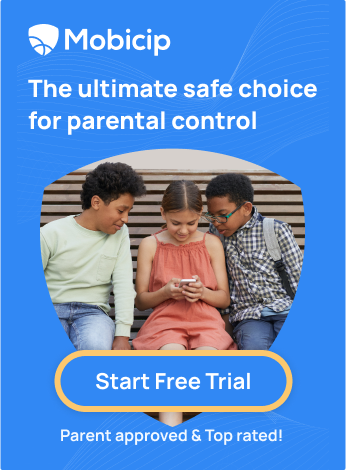Online child abuse: what it is and how to protect your child

Online child abuse is a unique form of child abuse also known as “Cyber Molestation” due to its virtual, distanced, and anonymous nature. Such abuse may not happen face-to-face, nor does it necessarily require physical contact. However, online abuse can result in negative face-to-face consequences in the form of statutory rape, forcible sexual assault, harassment, etc. If you are wondering how big the problem is, the US accounted for 30% of the global total of child sexual abuse material (CSAM) URLs at the end of March 2022, according to the Internet Watch Foundation.
What are the different forms of child online abuse?
Abusers can be of various demographics. They can be of different age, gender, ethnicity. And they can choose various means to harm the child online. Usually abusers are present in digital spaces where children visit often and can be accessed easily. Below are the most common forms of online abuse that happen every day.
Cyberbullying :
Bullying is no longer restricted to schools and playgrounds. It has expanded to the digital world. Cyberbullying is when a person or group of people hurt, embarrass, humiliate, or intimate a child over digital devices like cell phones, computers, laptops and tablets. It can occur through text messages, apps, social media, forums, or gaming sites, where people can view, participate in, or share content. Children who are bullied in schools are most likely to get bullied in the online world. According to Cyberbullying statistics from the i-SAFE foundation:
- Over half of adolescents and teens have been bullied online, and about the same number have engaged in bullying victims.
- More than 1 in 3 young adults have experienced cyber threats online.
- Over 25 percent of adolescents and teens have been bullied repeatedly through their cell phones or the Internet.
- Over half of the young people do not tell their parents when cyberbullying occurs.
Some common examples of cyberbullying can be:
- Posting comments about someone that is mean, hurtful and humiliating. We popularly call such statements trolls.
- Sending, posting, or sharing embarrassing, harmful, false, or mean content about a child.
- Threatening a child to make their personal information or pictures and videos publicly available.
- Taking unflattering pictures of a child offline and spreading them online
- Stealing a child’s account information to hack their account and send damaging messages
Online Grooming:
Grooming has been an age-old tactic of sexually exploiting children, wherein an adult befriends a child and builds trust to engage in sexual acts. In an offline setup, the groomers are usually known to the child's family and easy to spot, whereas online grooming is far more scary.
Online groomers can be a known adult, a stranger who impersonates someone else (popularly known as catfishing), or an adult who poses as a person of influence with the intent to facilitate online sexual contact. Online grooming can happen on sites and apps where young children are most active. Groomers may send friend requests through social media or strike conversations on online forums and game sites.
- 30% of 12-15-year olds said they had been contacted by a stranger online who wanted to be their friend.
Groomers develop an emotional connection with the child by being an encouragement, talking about similar interests, sending gifts, and flirtatious messages. Once they realize they have the child's trust, they steer sexual conversations, send intimate pictures of themselves, ask the child to send sexual photos and videos, or perform sexual acts over live streaming. The child sometimes may not realize the exploitation and think of online groomers as their boyfriends or girlfriends. They may feel love, loyalty and even admiration for their groomer. Groomers may invite children for a physical meet making things more dangerous and worse, leading to human trafficking, rape and even death.
In a recent real-life incident, a 15-year-old girl Kayleigh was groomed by a man named Harlow. He told her all the things many teenage girls want to hear. He told her she was beautiful, how much he cared for her and that she was special. The online meet ended in the rape and murder of dear Kayleigh.

Online Sexual Abuse:
Online sexual abuse is when a person manipulates and forces a child to engage in a sexual activity. It can be any type of sexual harassment, exploitation, or abuse that takes place through digital mediums. As technology has evolved so has the way abusers are targeting the children. In recent times, deeds such as “sextortion,” “revenge porn,” and “doxxing” are becoming increasingly popular.
Sexual abuse online may look like:
- Sending unwanted nude photographs to child via chat and through live streaming
- Sexting – engaging a child in a sexual chat by force
- Blackmailing a child to share their personal images and perform sexual acts through live streaming
Abusers use the vulnerability of children to induce fear, and anxiety in their minds. They threaten the children to do what they want by saying they’ll release sexual photos/videos if they don’t oblige. Often, abuse starts online and then takes place in person. The impact of online child abuse on the emotion and psychology of the child is the same as of in person.
Watch out for these signs in children who are experiencing child abuse
- Spending more time online than usual
- Usually looking for secretive places like toilets to use their devices
- Put off when asked to stop their online activities
- Academic performances have dropped significantly
- No longer interested in sports or other activities
- Withdraws or isolates from others
- Shows signs of anxiety, irritation, and anger
- Sexual behavior or knowledge that's inappropriate for the child's age
- Inappropriate behavior or bullying other children
- Starts receiving expensive gifts, money and clothes
- Sudden change in their mood or behavior
- Uses age-inappropriate languages
One or more red flags could indicate a child is suffering from online abuse. But then, some of these signs do not always mean that a child is experiencing abuse. As parents and adults, we must recognise the signs and address them to help resolve any issues that children and teenagers may face.
How, as a parent, can you prevent online child abuse?
As a parent, none of us would ever want our children to go through the trauma that online abuse may cause. We may have less control over other people's thoughts and actions. But then we can prepare our child to draw boundaries and take the right steps where necessary. Below are some practical tips that we may practice to keep our kids safe and protected.
Get involved
It is important our children receive the love and care they need at home. So they don't start looking for affirmations and comfort outside. As a parent, we need to spend time with our children and get involved in their lives. Work on fun and creative projects together, and develop a strong connection that helps children see home as a safe place to dwell.
Teach digital etiquette
Parents are children's first teachers. Teach your child how to use devices safely and have healthy interactions with people online. Make a list of do's and don'ts for digital usage and explain them to your child. Be open to sharing the dangers of online use and what they need to do if they encounter something disturbing.

Converse Regularly
Be curious about their digital life. Ask questions casually as you interact with them everyday. Discuss what they like and dislike about the digital space, new trends they are exploring, and friends they are making. Take this time also to share some pro tips and stories from your life that they may relate to and find interesting.
Build healthy digital habits
We all have a lot of reliance on technology, which is true for our children also. It is impractical to shut off technology entirely for fear of wrongs. The way forward is to team up with your children and help them develop healthy digital habits. This can include setting up healthy limits for screen usage, unplugging from devices on certain days and so on.
Supervise Digital Interactions
Supervising children and teens can prevent unwanted interactions, and it also helps you to be aware of what your child may be going through and offer help. Using parental control software like Mobicip scans your child's Instagram, Facebook and Snapchat for harmful content. It gives you real-time alerts to help you prevent cyberbullying and predatory attacks.
Whether you have your suspicions or your child comes to you on their own, respond with love and support if you learn your child is experiencing online abuse. Always be willing to listen to what they say and reassure them that you are there to help them resolve the issue. We can prevent online child abuse by lending a helping hand and building a safe support system for our children.
Keep in touch with the latest on parenting and technology. Subscribe to the Mobicip newsletter. Learn more at www.mobicip.com.






